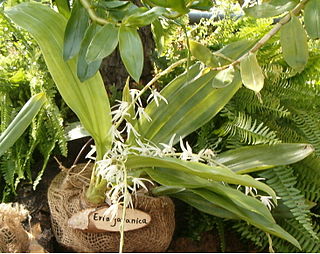
Alpinia is a genus of flowering plants in the ginger family, Zingiberaceae. It is named for Prospero Alpini, a 17th-century Italian botanist who specialized in exotic plants. Species are native to Asia, Australia, and the Pacific Islands, where they occur in tropical and subtropical climates. Several species are cultivated as ornamental plants. Species of the genus are known generally as shell ginger.
Trigonostemon is a plant genus of the family Euphorbiaceae and the sole member of its tribe (Trigonostemoneae). It was first described as a genus in 1826. It is native to Southeast Asia, southern China, the Indian Subcontinent, Queensland, and a few islands in the western Pacific.

Eria is a genus of orchids with more than 50 species distributed in China, the Himalayas, the Indian Subcontinent, Southeast Asia, New Guinea, Polynesia, Melanesia and Micronesia.

Dipodium, commonly known as hyacinth orchids, is a genus of about forty species of orchids native to tropical, subtropical and temperate regions of south-east Asia, New Guinea, the Pacific Islands and Australia. It includes both terrestrial and climbing species, some with leaves and some leafless, but all with large, often colourful flowers on tall flowering stems. It is the only genus of its alliance, Dipodium.

Richard Otto Maack was a 19th-century Russian naturalist, geographer, and anthropologist. He is most known for his exploration of the Russian Far East and Siberia, particularly the Ussuri and Amur River valleys. He wrote some of the first scientific descriptions of the natural history of remote Siberia and collected many biological specimens, many of which were original type specimens of previously unknown species.
This is a list of the flora of the South Sandwich Islands, a group of islands in the subantarctic Atlantic Ocean, part of the British overseas territory of South Georgia and the South Sandwich Islands. The list contains flora in the strict sense; that is, plants only. It comprises a single species of vascular plant, 38 mosses, and 11 liverworts. Unusually, not a single species is known to have naturalised on the islands; all are presumed native.

Chamaeanthus is a genus of flowering plants from the orchid family, Orchidaceae. Two species are currently recognized as of May 2014, both native to Taiwan and southeastern Asia.
Erythrodes is a genus of flowering plants from the orchid family, Orchidaceae. It contains 26 currently recognised species, native to Southeast Asia, China, the Indian Subcontinent, New Guinea, and some islands of the Pacific.
- Erythrodes amboinensis(J.J.Sm.) J.J.Sm. - Ambon
- Erythrodes bicalcarata(R.S.Rogers & C.T.White) W.Kittr. - New Guinea
- Erythrodes bicarinataSchltr. - New Guinea, Vanuatu
- Erythrodes blumei(Lindl.) Schltr. in K.M.Schumann & C.A.G.Lauterbach - from Assam east to Taiwan, south to Java
- Erythrodes boettcheriAmes - Luzon
- Erythrodes celebensisP.O'Byrne - Sulawesi
- Erythrodes forcipataSchltr. - New Guinea
- Erythrodes glandulosa(Lindl.) Ames - Borneo
- Erythrodes glaucescensSchltr. - New Guinea
- Erythrodes hirsuta(Griff.) Ormerod in G.Seidenfaden - Hainan, Assam, Bhutan, Myanmar, Thailand, Vietnam
- Erythrodes humilis(Blume) J.J.Sm. - Java, Sumatra, peninsular Malaysia
- Erythrodes johorensis(P.O'Byrne) Ormerod - peninsular Malaysia
- Erythrodes latifoliaBlume - Java, Sumatra, peninsular Malaysia
- Erythrodes latilobaOrmerod - Sri Lanka
- Erythrodes oxyglossaSchltr. - Fiji, New Caledonia, Samoa, Tonga, Vanuatu, Wallis & Futuna
- Erythrodes papuanaSchltr. in K.M.Schumann & C.A.G.Lauterbach - New Guinea
- Erythrodes parvulaKores - Fiji, Tonga
- Erythrodes praemorsaSchltr. - New Guinea
- Erythrodes purpurascensSchltr. in K.M.Schumann & C.A.G.Lauterbach - New Guinea, Fiji, Tonga, Samoa
- Erythrodes sepikanaSchltr. - New Guinea
- Erythrodes sutricalcarL.O.Williams - New Guinea
- Erythrodes tetrodontaOrmerod - New Guinea
- Erythrodes torricellensisSchltr. - New Guinea
- Erythrodes trilobaCarr - Sabah
- Erythrodes weberiAmes - Philippines
- Erythrodes wenzeliiAmes - Philippines
Hippeophyllum is a genus of flowering plants from the orchid family, Orchidaceae. It is native to New Guinea, insular Southeast Asia, and the Solomon Islands.
- Hippeophyllum albovirideJ.J.Sm. - New Guinea
- Hippeophyllum biakenaeJ.J.Sm. - New Guinea
- Hippeophyllum celebicumSchltr. - Sulawesi
- Hippeophyllum halmaherenseJ.J.Sm. - Halmahera
- Hippeophyllum hamadryas(Ridl.) Schltr. in K.M.Schumann & C.A.G.Lauterbach - New Guinea
- Hippeophyllum micranthumSchltr. in K.M.Schumann & C.A.G.Lauterbach - New Guinea, Solomon Islands
- Hippeophyllum papillosumSchltr. - New Guinea
- Hippeophyllum scortechinii(Hook.f.) Schltr. - Borneo, Java, Malaysia, Sulawesi, Sumatra
- Hippeophyllum sulenseJ.J.Sm. - Sula Islands in Maluku
- Hippeophyllum wenzeliiAmes - Leyte

Microsaccus is a genus of flowering plants from the orchid family, Orchidaceae. It is native to Southeast Asia.

Lophoziaceae is a family of liverworts belonging to the order Jungermanniales.

Kålhuvudet or the Kålhuvudets Nature Reserve is situated in Örnsköldsvik Municipality, in Björna parish of Västernorrland County in northern Sweden. It is located 7 km southwest of Hemling and covers 770 hectares.
Kanapia is a genus of flowering plants in the family Rubiaceae. The genus is endemic to the Philippines. It was described when two former Canthium species were transferred to this new genus.
Ataenius wenzelii is a species of aphodiine dung beetle in the family Scarabaeidae.
Lophozia collaris is a species of liverwort belonging to the family Lophoziaceae.
Lophozia is a genus of liverworts belonging to the family Lophoziaceae.






